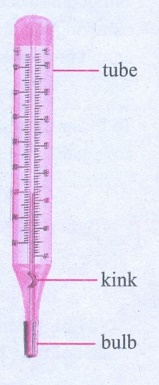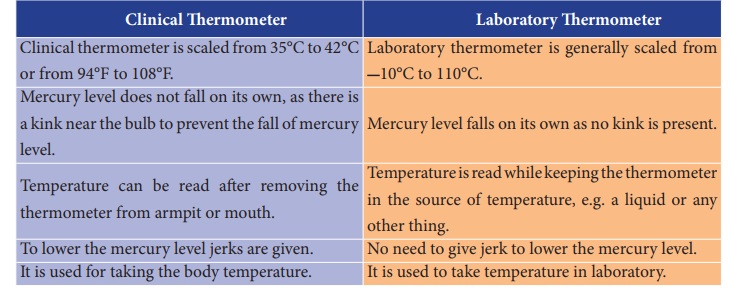Heat and Temperature | Term 2 Unit 1 | 7th Science - Questions Answers | 7th Science : Term 2 Unit 1 : Heat and Temperature
Chapter: 7th Science : Term 2 Unit 1 : Heat and Temperature
Questions Answers
EVALUATION
I. Choose
the correct answer
1. International
unit of measuring temperature is . ______________
a. Kelvin
b. Fahrenheit
c. Celsius
d. Joule
Answer: a) Kelvin
2. In
thermometer when bulb comes in contact with hot object, liquid inside it
a. expands
b. contracts
c. remains same
d. none of above
Answer: a. expands
3. The
body temperature of a healthy man is;
a. 0°C
b. 37°C
c. 98°C
d. 100°C
Answer: b. 37°C
4. Mercury
is often used in laboratory thermometers because it______________
a. is a harmless liquid
b. is silvery in colour and is attractive in
appearance
c. Expands uniformly
d. is a low cost liquid
Answer: c. expands uniformly
5. Which
of the following temperature conversions is incorrect
K ( Kelvin) = °C ( Celsius) + 273.15
°C K
a. -273.15
0
b. -123. +150.15
c. + 127. + 400.15
d. + 450 + 733.15
Answer: d. +450
= +733.15
II. Fill in
the blanks
1. Doctor uses clinical thermometer to
measure the human body temperature.
2. At room temperature Mercury is in liquid state.
3. Heat energy transfer from hot to cold
4. -7°C temperature is less than 0°C
temperature.
5. The common laboratory thermometer is
a Celsius scale thermometer
III. Match
the following
i. Clinical
thermometer - A form of energy
ii. Normal temperature human body - 100°C
of
iii. Heat - 37°C
iv. Boiling point of water - 0°C
v. Melting point of water - Kink
Answer :
i) Clinical
thermometer - Kink
ii) Normal
temperature of human body - 37°C
iii) Heat - A
form of energy
iv) Boiling point
of water - 100°C
v) Melting point of
water - 0°C
IV. Give
very short answer
1. Temperature
of Srinagar (J&K) is 4°C and in Kodaikanal is 3°C which of them has greater
temperature ? What is the difference between the temperatures of these two
places?
Kodaikanal has a higher temperature than Srinagar. The
temperature difference is 7°C.
2. Jyothi
was prepared to measure the temperature of hot water with a clinical
thermometer. Is it right or wrong? Why?
A clinical thermometer can be used only to measure body
temperature. It is scaled from 35°C to 42°C only. So it cannot be used to
measure the temperature of hot water because the temperature of hot water will
exceed 42°C. It is wrong to make such an attempt because the greater expansion
of mercury will cause the bulb to break.
3. A
clinical thermometer is not used to measure the temperature of air, why?
A clinical thermometer is scaled from 35°C to 42°C only. Its
bulb should be completely covered by the part of the body such as a patient's
armpit or under the tongue. So it cannot be used to measure the temperature of
air.
4. What
is the use of kink in clinical thermometer?
The kink prevents the mercury from flowing back into the bulb
when the thermometer is taken out of the patient's mouth. Therefore we can
measure the temperature conveniently.
5. Why do
we jerk a clinical thermometer before we measure the body temperature?
The mercury level in a clinical thermometer will remain in the
same high level even when it is taken out of the patient's mouth. So we jerk
the clinical thermometer to bring the level of mercury down.
V. Give
short Answer
1. Why do
we use Mercury in thermometers? Can water be used instead of mercury? What are
the problems in using it?
1. The expansion of mercury is uniform.
2. Mercury is opaque and shining.
3. Mercury does not stick to the side of the glass.
4. It is a good conductor of heat.
5. As it has highest boiling point and a low melting point a
wide range of temperatures can be measured using mercury.
6. Mercury remains in liquid form.
7. Even a small change in temperature causes visible expansion
in it.
Water cannot be used in a thermometer. The Relative Density of
mercury is 13.6 where as the R.D of water is just 1. So if we use water in a
thermometer the length of the thermometer tube should be 13.6 times longer. It
is not practicable. So we cannot use water in a thermometer.
2. Swathi
kept a laboratory thermometer in hot water for some time and took it out to
read the temperature. Ramani said it was a wrong way of measuring temperature.
Do you agree with Ramani? Explain your answer.
Yes, I agree with Ramani. The laboratory thermometer has no kink
in it. So when we take it out of the hot water the mercury level will drop down
immediately. So the laboratory thermometer should not be taken out of the hot
liquid while we note the reading.
3. The
body temperature of Srinath is 99°F. Is he suffering from fever? If so, why?
No, Srinath doesn't have a fever. The normal body temperature is
98.6°F. Srinath's body temperature is just 99°F. This slight difference cannot
be considered as fever because body temperature varies slightly from person to
person.
VI. Give
long answer
1. Draw
the diagram of a clinical thermometer and label its parts.

A clinical thermometer is a glass tube with a capillary tube at
the centre. It is connected to a bulb with mercury. Mercury can rise or fall
along the graduated capillary tube. All clinical thermometers have a kink that
prevents the mercury from flowing back into the bulb when the thermometer is
taken out of the patient's mouth, so that the temperature can be noted
conveniently. There are temperature scales on either side of the mercury
thread, one in Celsius scale and the other in Fahrenheit scale. Since the
Fahrenheit scale is more sensitive than the Celsius scale, body temperature is
measured in °F only. A clinical thermometer indicates temperatures from a
minimum of 35°C or 94°F to a maximum of 42°C or 108°F.
2. State
the similarities and differences between the laboratory thermometer and the
clinical thermometer.
Difference between clinical and laboratory thermometer
Both the thermometers have a bulb and a stem. Mercury is used in
both of them. These are the similarities. The differences are tabulated below.

Clinical
Thermometer
1. It is used for taking the body temperature.
2. Clinical thermometer is scaled from 35°C to 42°C or from 94°F
to 108°F.
3. Mercury level does not fall on its own, as there is a kink
near the bulb to prevent the fall of mercury level.
4. Temperature can be read after removing the thermometer from
armpit or mouth.
5. To lower the mercury level jerks are given.
Laboratory
Thermometer
1. It is used to take temperature in laboratory.
2. Laboratory thermometer is generally scaled from -10°C to
110°C.
3. Mercury level falls on its own as no kink is present.
4. Temperature is read while keeping the thermometer in the
source of temperature, e.g. a liquid or any other thing.
5. No need to give jerk to lower the mercury level.
VII. Higher
Order Thinking questions
1. What
must be the temperature in Fahrenheit, so that it will be twice its value in
Celsius?
-24.61°F temperature is
the Fahrenheit scale reading equal to twice that of the Celsius value.
2. Go to
a veterinary doctor (a doctor who treats animals). Discuss and find out the
normal temperature of domestic animals and birds.
The normal temperature of birds and animals are given below:
Birds have higher body temperature and much higher metabolism
than human beings. So, normal body temperature of birds are 40 degree Celsius
or 105 degree Fahrenheit which varies in different species of birds.
Body temperatures of domestic animals such as Cattle, Buffalo,
Cow, Sheep, Goat, Donkey, Horse, Pig, Dog and Chicken falls in the range of 38
to 42 degree Celsius (or 100.4 to 107.6 degree Fahrenheit).
Related Topics